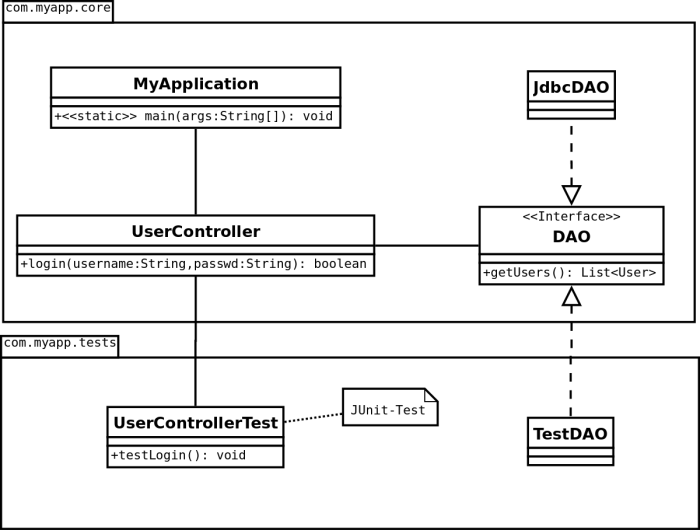Meeting 5
When: Monday, October 13th, 2008 - 19:00
Where: Freihaus HS4
In what follows we provide a simple formal model of this process. ,
Inhaltsverzeichnis
Guice
Download the slides (pdf, 115KB).
You can also view the slides online.
Download the sourcecode (pdf, 13KB).
Basic facts
Of course theory is nice, but it becomes useful when you start using a concret technology which enables dependency injection for you, such the Google Guice framework presented by Jan Zarnikov. It provides a pure Java style (no external XML configuration which makes it possible to misstype a name; refactorings also changes configuration!) with all Java5 features such as generics (type safety) and annotations (injecting is realized via Guice own annotations).
Cześć, to jest komentarz.Aby skswoaać komentarz po prostu zaloguj się i wyświetl komentarze do wpisu, gdzie znajdują się opcje ich edycji oraz usuwania.
Simple example
The following chapter shows a simple application with a database connection and a mocked connection for its unit tests:

The UserController class is subject of the JUnit test and requires a database (in fact, just something that implements the DAO interface). Because unit tests should only test a certain unit (and not the database management system or anything else), the controller class will get another implementation of DAO injected if it is run by JUnit (namely TestDAO instead of JdbcDAO).
Injecting objects is just as easy as annotating the constructor with the @Inject annotation (you could also have used it at the field itself, or provided a setter method):
<source lang="java">
public class UserController {
private final DAO dao;
@Inject
public UserController(DAO dao) {
this.dao = dao;
}
public boolean login(String username, String password) {
List<User> users = this.dao.getUsers();
// ...
}
} </source>
Of course you also have to configure your dependencies somewhere:
<source lang="java">
public class AppModule extends AbstractModule {
public void configure() {
bind(DAO.class).to(JdbcDAO.class);
}
}
public class TestModule extends AbstractModule {
public void configure() {
bind(DAO.class).to(TestDAO.class);
}
} </source>
To startup the Guice framework, you have to do following first:
<source lang="java">
public class MyApplication {
public static void main(String[] args) {
// configure Guice with AppModule
Injector injector = Guice.createInjector(new AppModule());
// userController already got its proper DAO instance injected UserController userController = injector.getInstance(UserController.class);
boolean isLoggedIn = userController.login("Foo", "Bar");
}
} </source>
Or use your special configuration for unit test:
<source lang="java">
public class UserControllerTest {
private UserController userController;
@Before
public void setup() {
// configure Guice with TestModule, instead with AppModule
Injector injector = Guice.createInjector(new TestModule());
this.userController = injector.getInstance(UserController.class);
´ }
// some tests...
} </source>
Links
- http://code.google.com/p/google-guice/ ... Official Guice website
- http://docs.google.com/View?docid=dd2fhx4z_5df5hw8 ... Official userguide
- http://crazybob.org/2007/06/introduction-to-guice-video-redux.html ... Presentation about Guice
- http://www.youtube.com/watch?v=FFXhXZnmEQM ... Other presentation about Guice
Springframework
Download the slides (pdf, 0.6MB).
You can also view the slides online.
If you're looking to buy these articles make it way esiaer.
Content
Spring should be part of every Java application today; at least so says the lecturer Christoph Pickl. If it is not Spring, it should be any other framework which enables dependency injection. Spring ...
- ... is a leightweight inversion of control and aspect oriented container framework.
- ... makes developing JEE applications easier and more fun!
Spring's mission statements are:
- JEE should be easier to use.
- It is best to program to interfaces, rather than classes [...]
- JavaBeans offer a great way of configuring applications.
- OO is more important than any implementation technology [...]
- Checked exceptions are overused in Java [...]
- Testability is essential [...]
Each and every bean declarations got a beans root node declaring some namespaces:
<source lang="xml">
<?xml version="1.0" encoding="UTF-8"?>
<beans
xmlns="http://www.springframework.org/schema/beans" xmlns:xsi="http://www.w3.org/2001/XMLSchema-instance" xsi:schemaLocation="http://www.springframework.org/schema/beans http://www.springframework.org/schema/beans/spring-beans-2.0.xsd"
>
</beans>
</source>
One could, for example, define a single dao-instance, and reuse that instance by injecting it into different controller classes:
<source lang="xml">
<bean id="myDao" class="jsug.MyDao" />
<bean id="myCtrl1" class="jsug.MyController1">
<property name="dao"> <ref bean="myDao" /> </property>
</bean>
<bean id="myCtrl2" class="jsug.MyController2">
<property name="dao"> <ref bean="myDao" /> </property>
</bean> </source>
Using the springframework today is very non-intrusive. Just load your application context and that's it:
<source lang="java">
// single code dependency to spring throughout our whole application
import org.springframework.context.support.ClassPathXmlApplicationContext;
public class App {
public static void main(String[] args) {
String[] beanDefinitions = { "/beans.xml" };
new ClassPathXmlApplicationContext(beanDefinitions);
}
public App() {
// spring will invoke this constructor for us
}
public void init() {
// and spring will also invoke this initialize method for us
}
} </source>
Sometimes, your beans have to be initialized via a certain method. To do this, declare your bean as follows:
<source lang="xml">
<bean id="myBean" class="jsug.MyBean" init-method="init">
<constructor-arg index="0" value="someStringValue" /> <constructor-arg index="1" ref="someOtherBean" /> <property name="firstName" value="Christoph" />
</bean> </source>
The corresponding class: <source lang="java"> public class MyBean {
private final String someString;
private String firstName;
// #1 first of all, the bean will be created with proper constructor args
public MyBean(String someString, Bean b) {
this.someString = someString;
}
// #2 afterwards, all properties will be set via setter methods
public void setFirstName(String firstName) {
this.firstName = firstName;
}
// #3 finally, the initialize method will get invoked
public void init() {
// initialize bean in here
}
} </source>
Links
- http://www.springframework.org ... Official Website
- http://parleys.com/display/...Injection%20Frameworks ... Short presentation "Comparing Dependency Injection Frameworks"
Gallery
Thanks to Jan for providing these pictures.


